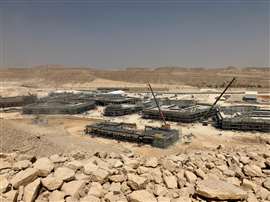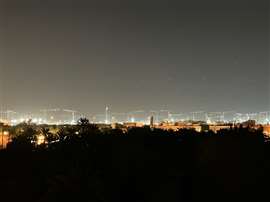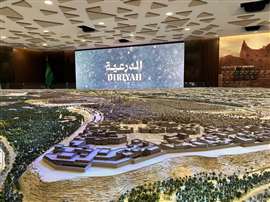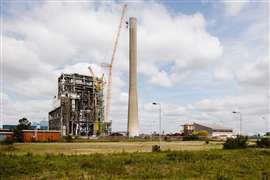Read this article in 中文 Français Deutsch Italiano Português Español
Inside Saudi Arabia’s construction surge: three key takeaways
13 October 2025
As a shorthand, everything you need to know about the Saudi Arabian construction industry can be gleaned from the drive from the airport to the capital, Riyadh. Along the route – a distance of around 35km (21 miles) – even the most unobservant of people will be struck by the sheer amount of construction work taking place.
 One of the many construction projects that makes up the megaproject of Diriyah
One of the many construction projects that makes up the megaproject of Diriyah
And it’s not just construction work on a small to medium scale, such as new office buildings or parking lots – it is construction on a massive scale, with the ambition and budget to match.
Some of the projects include King Salman Park, the Expo 2030 site, New Murabba (including the Mukaab – one of the world’s largest structures, shaped like a 400-metre cube) and Qiddiya, a massive new entertainment city.
Much has been written about NEOM’s The Line project, which has been scaled back in terms of its size and scope. Given just how ambitious – even outlandish – the initial plans were, this is not a surprise.
However, its scaling back should not be mistaken for a slowdown in Saudi Arabia’s construction activity as a whole; the opposite is true.
This editor visited Saudi Arabia for the first time at the invitation of the US$63.5 billion megaproject Diriyah, which aims to transform a UNESCO heritage site into a thriving tourism and hospitality community. Construction is said to be both on time and on budget. Some of Diriyah’s projects include a US$1.4 billion opera house, a golf course designed by Greg Norman, and Armani and Ritz-Carlton-branded hotels.
Three key takeaways about the construction industry in Saudi Arabia
1) Saudi Arabia construction is on a grand scale
 Tower cranes on the horizon are a familiar sight in Saudi Arabia
Tower cranes on the horizon are a familiar sight in Saudi Arabia
On one of the construction projects in Diriyah, it was reported that there were 83 tower cranes in operation – a record number for a single project in the region, according to some. Until you actually see these sites for yourself, it is hard to adequately describe just how big they are.
In a talk to a group of journalists, Kiran Jay Haslam, chief marketing officer of Diriyah, revealed, “We currently have around 51,000 workers on site. That number goes up all the time, so I have to always check I have the most recent figure.
“When we started on this project we had 12,000 people, and construction is accelerating as we move towards Vision 2030 and World Expo 2030, of which Diriyah is a big part.”
2) The power of the Saudi Public Investment Fund
Saudi Arabia’s Public Investment Fund (PIF) is one of the largest sovereign wealth funds in the world. Most of the megaprojects in the country have their own management and ownership structures and report up into PIF, but it is also the case that PIF directly manages some projects itself.
 The US$63.5 billion megaproject Diriyah, which aims to transform a UNESCO heritage site into a thriving tourism and hospitality community
The US$63.5 billion megaproject Diriyah, which aims to transform a UNESCO heritage site into a thriving tourism and hospitality community
The sheer size and resources of PIF is one of the reasons, according to Haslam, that the Diriyah project has been able to remain on time and on budget.
“We work closely with all the ministries, and PIF helps to ensure that the right projects are prioritised and have the resources they need.”
Like elsewhere, construction in Saudi Arabia faces challenges around workforce shortages. With so many projects underway simultaneously, there is always the risk of not having enough skilled workers to go around.
However, this is mitigated by having one central authority – PIF – overseeing all projects and ensuring resources are distributed where needed to keep work on track.
3) Ambitions aplenty in Saudi Arabia
 Construction Briefing and International Construction editor Andy Brown spent three days in Saudi Arabia
Construction Briefing and International Construction editor Andy Brown spent three days in Saudi Arabia
Vision 2030 has been the driving force behind much of Saudi Arabia’s construction activity as the country looks to diversify its economy away from oil and establish itself as a global tourism and entertainment hub, much like Dubai.
What’s interesting from speaking to people in the country informally is how many believe that Vision 2030 – the deadline for many of today’s megaprojects – will not mark the end of this construction boom.
More than one person suggested that Saudi Arabia will, in the not-too-distant future, look towards the next phase of its development – perhaps Vision 2040 or 2050.
While these views are, of course, unofficial, they offer an insight into how people within the country see the future: Saudi Arabia has not – by a long shot – seen the last of its megaprojects.
STAY CONNECTED


Receive the information you need when you need it through our world-leading magazines, newsletters and daily briefings.
CONNECT WITH THE TEAM











